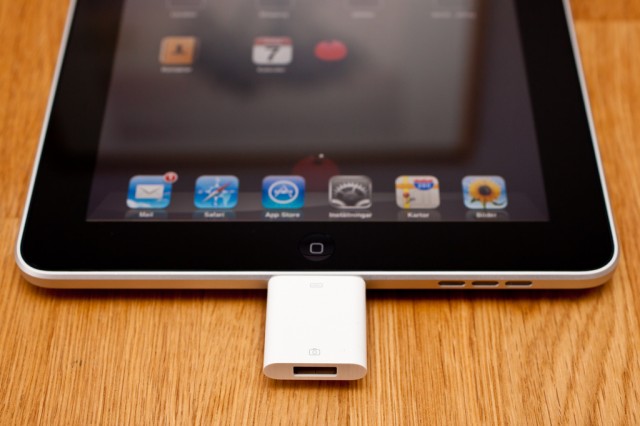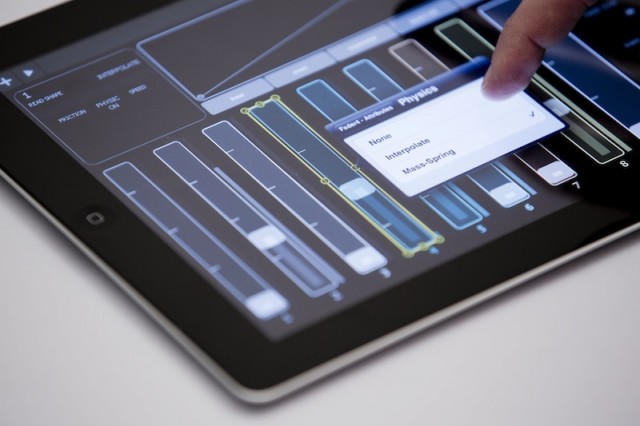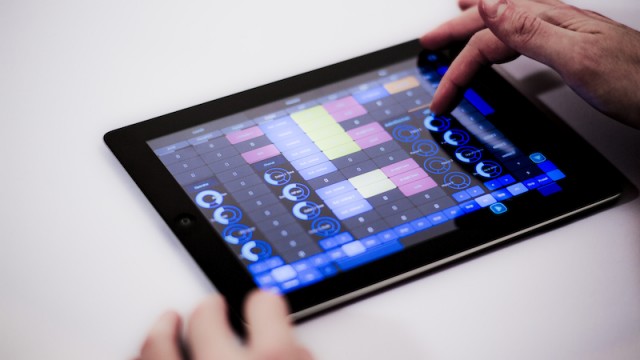
Apple’s iPad Camera Connection Kit, providing a USB port, as connected to a first-gen iPad. (CC-BY) Håkan Dahlström Photography
You know the possibilities are significant, but how do you explore them? iPad, Ableton Live, MIDI, OSC, Wi-Fi, MIDI … how can you connect your iPad to other tools for music control?
We brought in an expert, Nicolas Bougaïeff, Creative Director at Liine, to explain the different routes, including not only wireless, but wired solutions, too. Liine is the maker of Lemur and popular Ableton Live control apps (LiveControl 2 being the most recent). Nicolas naturally builds on that expertise, but the lessons here apply to a range of iOS apps. This tutorial should answer some questions for beginners and fairly advanced users alike. -PK
The iPad is an amazing tool to make music and controller apps can be very powerful. Lemur, for example, enables you to control other apps running on the same iPad, apps running on another iPad, software running on a laptop such as Ableton Live, or even hardware such as synthesizers and drum machines.
But connecting apps together can be confusing. This article provides a reference to the various options for iOS connectivity, including a focus on controlling Ableton Live. Lemur will be the main example used during the article, but the information contained here is certainly relevant to any iPad control app.
What Is the Difference Between MIDI and OSC?
MIDI is a protocol invented in the early 1980s for connecting music gear. It’s not the best, or the fastest, but it is the standard. MIDI is supported by just about every piece of music hardware and software manufactured in the past 30 years, and that now includes iPads and iPhones. Starting with iOS 5, Apple has made the CoreMIDI library available, which enables MIDI transmission over network (i.e. Network MIDI) and hardware adapters (various options described later in this article). MIDI support is now a more or less standard feature in professional iOS music apps.
OSC is a protocol invented in the late 1990s that offers many improvements:
- Higher bandwidth (more information flowing faster)
- Transmission over ethernet. Ed.: technically, MIDI can run on any transport, Ethernet included, but OSC is built from the ground up as a networking protocol.)
- High-resolution data types (rather than 7/14 bit supported by MIDI)
- Open-ended URL-type addressing scheme (rather than port/channel MIDI system)
While OSC is very powerful, MIDI remains the most widely-supported standard. Some apps support MIDI, some apps support OSC and some apps, such as Lemur, support both.
[Note to LiveControl 2 users: LiveControl 2 relies exclusively on MIDI messages, so all MIDI connection options supported by Lemur are available to you.]
Cables and Wi-Fi Networks
Connections between your iPad apps and other physical devices (laptop, synthesizer) can be made either over a Wi-Fi network or with a cable. MIDI apps can be easily used either over a Wi-Fi network or with hardware cables. OSC apps can only easily be used over Wi-Fi.
Wi-Fi connections, while usually stable, can occasionally suffer from interference, drop-outs, or jitter. This is more likely to happen when you play in a new venue where you have little control over the networks present in the room. This is obviously an important risk to take into account when planning a public, live performance. CoreMIDI-compatible apps over hardware cables give you a 100%-guaranteed connection and the lowest possible latency between the iPad and laptop, as responsive as hardware MIDI controllers.
Ed.: Your wifi card can also die on you, which happened to me recently on my MacBook Pro, so having a backup connection strategy can be appealing!
You might also want to read this recent Synthtopia write-up of performance tests being done by a Wi-Fi MIDI adapter maker:
Can Wireless MIDI Be As Fast As Wired MIDI?
But as a commenter notes, those figures are average, not worst-case, scenarios. Reliable performance is the key here, as Nick says.
Wi-Fi routers and ad-hoc networks
There are two different ways to connect your iPad to your laptop over a Wi-Fi network. The first option is to connect both to the same router — for example, the router you may already have for your internet connection. The second option is to create a computer-to-computer network, otherwise known as an ad-hoc network.
Connecting through a router works just fine for many people. Depending on the sort of work you’re doing, this could work fine for you too. However, you must consider that you will experience higher latency when connecting through a router. It could take up to 200-300ms for fader movements and button taps to reach the computer. If you’re programming beats in real time, that can be quite long! On the other hand, if you’re just riding volume faders, the difference might not matter.
Connecting through an ad-hoc network is a little bit more work, but you can achieve very low latency, typically down to the 10-20 ms range. There are many good guides on how to create and manage ad-hoc networks for OS X and all versions of Windows. You can check out the many articles on http://support.liine.net or a quick Google or YouTube search will yield many results. Ed.: On Mac, this is as simple as choosing “Create Network” from the Wi-Fi menu, and Windows requires only a couple of additional steps.
Static IPs deserve a short mention. Static IPs are only necessary as a last resort, when all previous ad-hoc connection attempts have failed. While not necessary, learning about configuring static IPs may be worth the effort to you if you wish to be in total control of the network settings.
OSC over Wi-Fi
OSC was designed to work over networks and does so very well. In most cases, Wi-Fi is the only way to connect OSC-compatible iPad apps to your laptop.
OSC over Cable
There is an option for using OSC-compatible iOS apps over a hardware cable, but given that it uses the Personal Hotpost for something other than Apple’s (apparent) intention, it could be considered something of a workaround. This option is largely untested, but a quick trial at the Liine HQ seemed promising.
If you have a 3G/LTE (4G)-enabled device, unlocked, or with a carrier that allows tethering, then you will be able to use the Personal Hotspot feature to enable a network connection between your iPad and laptop through an Apple Sync Cable (USB to 30-pin or USB to Lightning). Note that Cellular Data must be turned on in order for the Personal Hotspot function to be available. If you’re abroad and want to avoid any unwanted charges, make sure to turn Data Roaming off, while keeping Cellular Data on. Once a network connection is established in this way, OSC and Network MIDI can be freely used while also charging your device at the same time. If you are a devout OSC user who performs live, this may be an avenue worth exploring. For further information, this Apple knowledge base entry may be helpful: http://support.apple.com/kb/ht4517
In addition, some users have reported successfully using OSC apps over the Apple Sync Cable by first jailbreaking the device, then using MyWi. This author strongly recommends against doing so, as you would break the Apple EULA and effectively void your warranty.
MIDI over Wi-Fi
MIDI over Wi-Fi is supported natively on OS X through a built-in tool called Network MIDI, which you can find in /Applications/Utilities/Audio MIDI Setup. On Windows, rtpMIDI emulates Apple’s Network MIDI driver. Network MIDI is a subset of CoreMIDI functions that applies to transmitting MIDI data over a network. Virtually all CoreMIDI-compatible apps support Network MIDI.
Lemur supports CoreMIDI but, exceptionally, does not support Network MIDI. Instead, Liine created Lemur Daemon, a utility that allows up to eight MIDI ports, thus circumventing Network MIDI’s limitation of a single MIDI port. Such flexibility is necessary in many professional situations.
MIDI over Cable
You have a choice between three types of iOS MIDI adapters, as well as Network MIDI over the Apple Sync Cable.
1) The first type, and most highly recommended, is devices that are both USB- and CoreMIDI-compliant. That means that the device plugs into your iPad at one end, and plugs into a USB port of your laptop at the other end. These devices provide a direct connect between your iPad and laptop.The best in this category are the iConnect MIDI line of products, such as iConnectMIDI2+ and iConnectMIDI 4+. The Alesis iO Dock unfortunately does not support SysEx messages, thus making it incompatible with many MIDI apps (including LiveControl 2) and hardware synthesizers. The Behringer iS202, although untested, appears to be a working model and its specs do specifically mention SysEx support. For any of these devices, the setup looks like this:
iPad -> iConnectMIDI2+ -> Laptop.
2) The second type of iOS MIDI adapter standard 5-pin MIDI cables coming from your iPad. This is very useful if you want to use your iPad to control a hardware synthesizer, but if you want to connect to your laptop then you will additionally need a soundcard with physical MIDI ports or a MIDI interface. A good example of this type of adapter is the iRig MIDI II, which plugs into the iPad at one end, and has MIDI cables at the other end. A typical setup in this case would be:
iPad -> iRig MIDI II -> Audio/MIDI Interface -> Laptop.
3) The third type of connection relies on Apple’s Camera Connection Kit. That is a small adapter that plugs into your iPad and simply has a female USB socket. You can then connect any Class Compliant audio/MIDI interface (Class Compliant means that you don’t need to install any drivers, it just works). If the goal is to connect the iPad to the laptop, then most elegant solution is to use a simple 1in/1out USB to MIDI adapter, such as the ESI Midi Mate II, M-Audio Uno or the iConnectMIDI1. As with type 2 above, you still need to connect the physical MIDI cables from the interface to another interface on your computer. A setup in this case could resemble the following:
iPad -> CCK -> M-Audio Uno -> Audio Interface -> Laptop.
As you can see, the first option is the simplest and involves the least amount of things, whereas the second and third option require more cables and connections. For any serious musician using an iPad and MIDI apps, this author highly recommend the iConnectMIDI2+ and iConnectMIDI4+.
Finally, if you have Personal Hotspot enabled (described in the ‘OSC over Cable’ section above), you may be able to connect with Network MIDI over the Apple Sync Cable. This one hasn’t been tested in-house, but in theory it should work for any CoreMIDI app or for apps with custom MIDI protocols such as the Lemur Daemon.
Conclusions
The iPad is a very powerful platform for music-making, and many apps support OSC, MIDI or both. Lemur supports both. You can connect the iPad to the external world over Wi-Fi or cables, but not all combinations of OSC/MIDI and Wi-Fi/cables are optimal. The most reliable type of connection is MIDI over hardware cables.
Whatever the app you’re using, here are some general rules about connections on iOS that always apply.
- Apps that use MIDI can connect over Wi-Fi or compatible hardware adapters.
- Apps that use OSC can connect over Wi-Fi.
There are three types of iOS MIDI adapters. The most efficient for connecting to a laptop are the iConnectMIDI2+ and iConnectMIDI4+. Other options, such as the iRig MIDI II or the Camera Connection Kit (CCK) give you the option to connect to hardware gear with MIDI cables, but involve more connections and devices to connect to a laptop.
More on Liine.
More on Nick, in the great Attack magazine, and a series called “Job Envy”:
CREATIVE DIRECTOR – NICOLAS BOUGAÏEFF
His official site:





